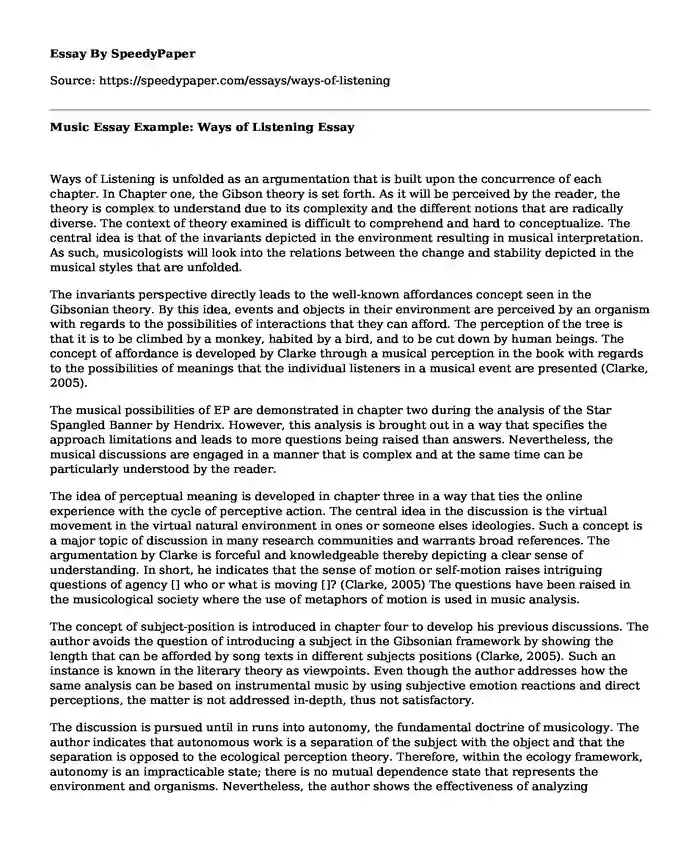Ways of Listening is unfolded as an argumentation that is built upon the concurrence of each chapter. In Chapter one, the Gibson theory is set forth. As it will be perceived by the reader, the theory is complex to understand due to its complexity and the different notions that are radically diverse. The context of theory examined is difficult to comprehend and hard to conceptualize. The central idea is that of the invariants depicted in the environment resulting in musical interpretation. As such, musicologists will look into the relations between the change and stability depicted in the musical styles that are unfolded.
The invariants perspective directly leads to the well-known affordances concept seen in the Gibsonian theory. By this idea, events and objects in their environment are perceived by an organism with regards to the possibilities of interactions that they can afford. The perception of the tree is that it is to be climbed by a monkey, habited by a bird, and to be cut down by human beings. The concept of affordance is developed by Clarke through a musical perception in the book with regards to the possibilities of meanings that the individual listeners in a musical event are presented (Clarke, 2005).
The musical possibilities of EP are demonstrated in chapter two during the analysis of the Star Spangled Banner by Hendrix. However, this analysis is brought out in a way that specifies the approach limitations and leads to more questions being raised than answers. Nevertheless, the musical discussions are engaged in a manner that is complex and at the same time can be particularly understood by the reader.
The idea of perceptual meaning is developed in chapter three in a way that ties the online experience with the cycle of perceptive action. The central idea in the discussion is the virtual movement in the virtual natural environment in ones or someone elses ideologies. Such a concept is a major topic of discussion in many research communities and warrants broad references. The argumentation by Clarke is forceful and knowledgeable thereby depicting a clear sense of understanding. In short, he indicates that the sense of motion or self-motion raises intriguing questions of agency [] who or what is moving []? (Clarke, 2005) The questions have been raised in the musicological society where the use of metaphors of motion is used in music analysis.
The concept of subject-position is introduced in chapter four to develop his previous discussions. The author avoids the question of introducing a subject in the Gibsonian framework by showing the length that can be afforded by song texts in different subjects positions (Clarke, 2005). Such an instance is known in the literary theory as viewpoints. Even though the author addresses how the same analysis can be based on instrumental music by using subjective emotion reactions and direct perceptions, the matter is not addressed in-depth, thus not satisfactory.
The discussion is pursued until in runs into autonomy, the fundamental doctrine of musicology. The author indicates that autonomous work is a separation of the subject with the object and that the separation is opposed to the ecological perception theory. Therefore, within the ecology framework, autonomy is an impracticable state; there is no mutual dependence state that represents the environment and organisms. Nevertheless, the author shows the effectiveness of analyzing autonomy and the accompanying absolute music notion with regards to EP. It is proposed that music presents a virtual world where there are many listening strategies that can be made possible including seeing music as an independent object. The fundamental principle here is grounding analytical approaches and listening strategies in auditory awareness.
The examination of the initial development of Beethovens String Quartet is offered practically in chapter six. The perceptual vs. structural analysis is discussed; the author comments based on his argumentation on the Agawus and Hattens semiotically analytical hypotheses. As such, music autonomy is deceptive as it is hypothetically indefensible.
Reference
Clarke, E. F. (2005). Ways of listening: An ecological approach to the perception of musical meaning. Oxford: Oxford University Press.
Cite this page
Music Essay Example: Ways of Listening. (2019, Jun 04). Retrieved from https://speedypaper.com/essays/ways-of-listening
Request Removal
If you are the original author of this essay and no longer wish to have it published on the SpeedyPaper website, please click below to request its removal:
- Application for the Assistant Management Position. Free Essay.
- Classification of Movies - Essay Example
- Free Essay on the Theme of Trauma and War
- Essay Example on Business Law and Ethics
- Essay Example on the Effect of the Author's Moral Viewpoint on Torture
- Alterations to Budget When Retired Due to Sickness Essay Example
- Free Essay Example on Nursing-Quality Indicators
Popular categories





